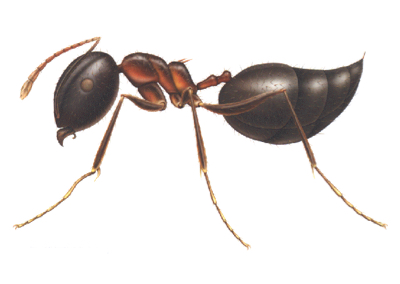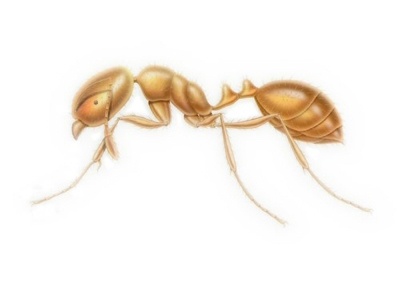Carpenter Ant
Our remedy for carpenter ant control
First, contact us. Successful carpenter ant control depends on eliminating the parent colony, which is usually located outdoors. Finding and treating as many satellite nests as possible is the key to effective carpenter ant control. Sometimes, a property can have several nests besides the main colony site. Because it can be difficult to detect these all at the same time, an ongoing pest program will ensure that any activity is addressed immediately to keep the population under control.
To prevent carpenter ants from invading your property, store firewood away from your house, trim dead limbs from trees, and remove stumps and lumber from around the house. Make sure landscape and mulch is not saturated with water. The softer and more rotten the wood is, the more attractive it will be to a carpenter ant. A frequently overlooked ant control measure is to make sure that all plumbing or roof leaks are sealed.
Carpenter ants, pavement ants, spiders, wasps and so many other pests are all covered under our Healthy Home Maintenance Program.

How to Identify a Carpenter Ant
Appearance
Among the largest of ants, 1/4 to 1/2″ long. The most common species is black, but some are dark red or brown.
Habitat
Carpenter ants are the most common property pest in the Midwest. Home and business owners are far more likely to face an invasion of carpenter ants than termites.
Carpenter ants get their name because they excavate wood in order to build their nests, leaving hollowed-out tunnels. These colonies require a constant source of water to survive, and are often found in wet, decayed wood such as dead limbs and tree stumps. Inside, they can be found in overly wet, poorly ventilated spaces such as crawl spaces or attics. While carpenter ants don’t eat wood, their excavations pose a property threat, making ant control imperative. In the spring, winged reproductive ants called swarmers fly out to start new colonies.
Diet
Will feed on nearly anything people eat—particularly sweets and meats. Will also feed on other insects. Carpenter ants do not eat wood. They just chew through it.
Additional Imagery
Is This Your Critter?
Maybe it is, maybe it isn’t. We can handle the identification and get you a solution to your problem quickly.
Get a remedy now. Send a message!
Carpenter Ant FAQs
What Is a Carpenter Ant?
Carpenter ants, aptly named for their construction prowess within wood, exhibit fascinating behaviors that distinguish them as a unique species of ant. These industrious insects carve through wood, meticulously crafting smooth tunnels to create their nests. Despite their name, carpenter ants do not feast on wood; rather, they excavate it, often leaving behind telltale signs, such as piles of sawdust, indicative of their presence and the potential need for eradication.
What Do Carpenter Ants Look Like?
In appearance, carpenter ants showcase a spectrum of colors and sizes, ranging from sleek black to striking combinations of black and red or even solid red or brown hues. Typically measuring between ½” to ⅝” in length, their varied appearances add to the intrigue surrounding these wood-working insects.
How Can I Spot Carpenter Ants Indoors?
Spotting carpenter ants indoors can be a cause for concern, especially upon the emergence of winged males, which often signals the presence of an indoor nest. Additionally, subtle rustling sounds emanating from wall voids or wood structures may hint at nest locations. Even a lone ant sighting can serve as an ominous indicator of a potential infestation, prompting homeowners to remain vigilant.
How Can We Prevent Carpenter Ants?
Preventing carpenter ant infestations requires proactive measures aimed at eliminating conducive conditions. Strategies include eradicating moisture sources, maintaining trimmed plant growth to deter ant pathways, sealing entry points, and storing wood away from the home to minimize attractiveness to these industrious insects.
How Do I Detect a Full Infestation?
Detecting a full infestation demands keen observation of subtle signs. Look for small wood openings accompanied by expelled debris, indicating active nest sites. These nests typically feature clean galleries with smooth walls, distinguishing them from other types of insect habitats.
Do Carpenter Ants Bite?
Yes, carpenter ants do bite, and their bites can be painful. Often, these bites are accompanied by the injection of formic acid, which can intensify the discomfort. While carpenter ant bites rarely pose significant health risks, prompt wound cleaning is advised to prevent potential infection.
How Do Carpenter Ants Infiltrate Buildings?
Carpenter ants exhibit remarkable infiltration capabilities, gaining access to buildings through various entry points such as cracks, plumbing, electrical penetrations, or even outdoor wires and vegetation that come into contact with the structure.
What Do Carpenter Ants Eat?
In terms of diet, carpenter ants display a diverse palate, primarily feeding on insect honeydew, plant juices, and other arthropods. Indoors, they may also indulge in a variety of food sources, including sweets, meats, and grease.
Which Wood Do Carpenter Ants Attack?
Regarding their choice of wood, carpenter ants exhibit a preference for moist or mold-damaged wood, which provides an ideal environment for nest construction. However, they may also extend their excavations to dry, undamaged wood over time.
What’s a Typical Carpenter Ant Colony Size?
Carpenter ant colonies vary in size, with mature colonies hosting anywhere from 10,000 to over 50,000 individuals, typically led by a single queen. Swarmers, which facilitate mating flights, emerge under specific environmental conditions, contributing to colony expansion.
Where Do Carpenter Ants Nest?
Nesting preferences for carpenter ants span various outdoor wood sources, including stumps, fence posts, and firewood. These locations serve as ideal habitats for colony establishment and expansion.
What Can I Do About Carpenter Ant Extermination?
Carpenter ant extermination is best left to professional pest control experts, given the size and complexity of infestations. These professionals possess the knowledge and tools necessary to assess the extent of the problem and implement effective eradication methods.
Can You Rid Carpenter Ants From My House?
Franklin Pest Solutions is happy to answer your questions related to how to get rid of carpenter ants and signs of carpenter ants in houses. We provide services for homeowners who live within a 50 mile radius from each of our branch locations in Hammond, Michigan City, Lafayette, New Albany, Indianapolis, and South Bend, IN.

Answered all my questions and walked me through every step of the service.
“Very informative, prompt, professional, and friendly! Answered all my questions and walked me through every step of the service. I would recommend to anyone I know.”
Celina M. | Homeowner
Merrillville, IN
Safe For Your Family and Business
We’re licensed, trained, and certified by the Departments of Public Health and Agriculture, using safe, EPA-regulated materials, always.
Attacking Infestations at the Root
We don’t come in spraying. We evaluate the root of your problem, and recommend and enact pre-emptive measures before any chemicals are used.
Assessments Before Any Contracts
Our Customer Care Center walks you through every service, every charge, and every solution before you agree to anything. Our commitment is to you.














